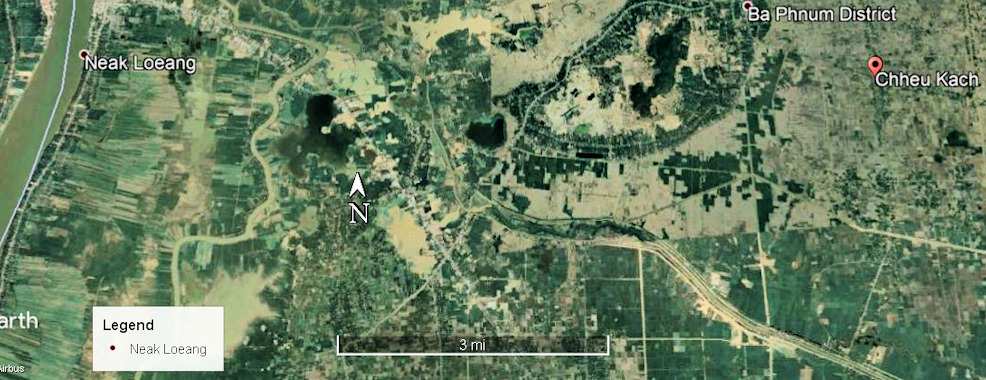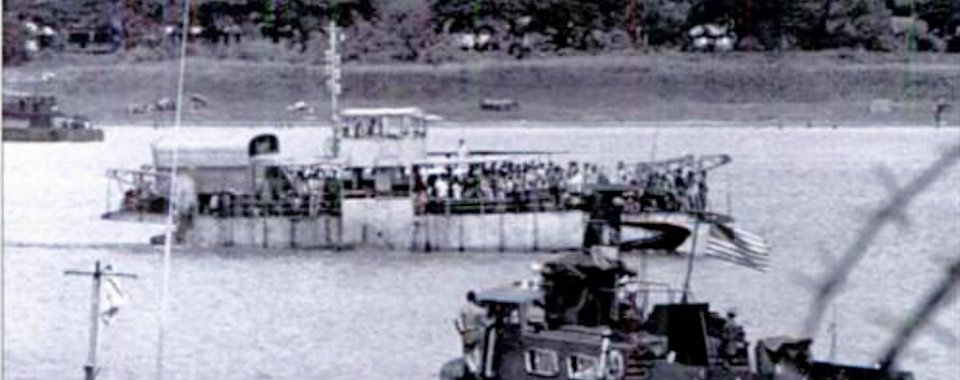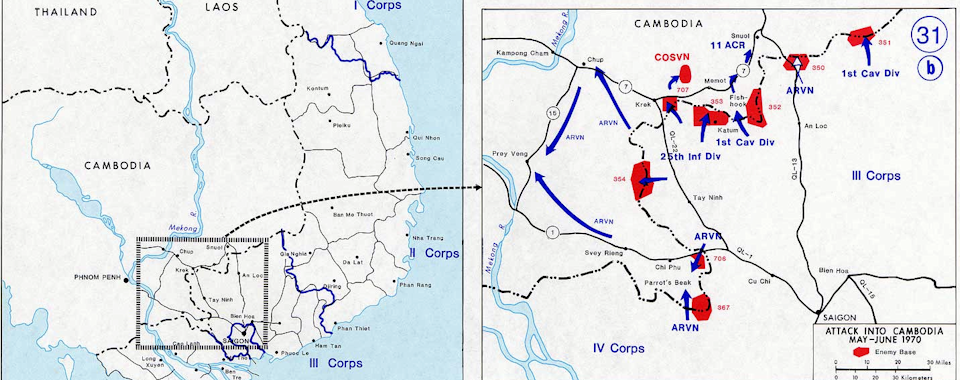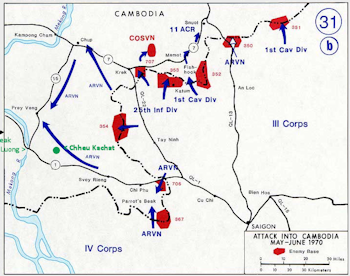 The Cambodian Campaign (also known as the Cambodian incursion and the Cambodian invasion) was a series of 13 military operations conducted in eastern Cambodia by the Army of the Republic of Vietnam (ARVN) between April 29th and July 22nd and by U.S. forces between May 1st and June 30th, 1970. The objective of the campaign was the defeat of the approximately 40,000 troops of the People's Army of Vietnam (PAVN) and the Viet Cong (VC) in the eastern border regions of Cambodia. The US was shifting toward a policy of Vietnamization and withdrawal when a change in the Cambodian government gave the US a chance to shore up the South Vietnamese government by eliminating the cross-border threat by destroying enemy bases in Cambodia.
The Cambodian Campaign (also known as the Cambodian incursion and the Cambodian invasion) was a series of 13 military operations conducted in eastern Cambodia by the Army of the Republic of Vietnam (ARVN) between April 29th and July 22nd and by U.S. forces between May 1st and June 30th, 1970. The objective of the campaign was the defeat of the approximately 40,000 troops of the People's Army of Vietnam (PAVN) and the Viet Cong (VC) in the eastern border regions of Cambodia. The US was shifting toward a policy of Vietnamization and withdrawal when a change in the Cambodian government gave the US a chance to shore up the South Vietnamese government by eliminating the cross-border threat by destroying enemy bases in Cambodia.
By Charlie Sapp, CAPT, USN (Ret)
From time to time, those who served in an active war zone are asked to recount what they did in the war. For those who spent their time in the decidedly unromantic trade of providing close air support for troops on the ground, they are sometimes asked to explain why they would not rather be a fighter pilot. Both questions are answered in this tale of uncommon courage, tenacity, and just-in-time delivery. It is also an excellent example of the critical role played by the Black Ponies of Light Attack Squadron Four in the war in the Mekong Delta, in this case supporting the 1970 Cambodia Incursion.
At 0730 on May 9, 1970, a joint U.S. / Vietnamese task force comprised of over 140 vessels headed north on the Mekong River and crossed the border into Cambodia. The U.S. contribution to the force was comprised of afloat elements of Operation SEALORDS as well as U.S. advisors with the Vietnamese units and dedicated air support from HAL-3's Seawolves and VAL-4's Black Ponies.
The U.S. forces were under the command of Rear Admiral H. S. Matthews, First SEALORDS as well as Deputy Commander, Naval Forces Vietnam, who was overseeing operations from USS BENEWAH located on the Mekong River just south of the border at Tan Chau. With the Fifth Infantry Battalion of Vietnamese Marines and their two American advisors embarked, it was the largest task force assembled in the history of the Vietnam War.
The task force was part of President Nixon's incursion into Cambodia to root out communist sanctuaries. It's mission was to secure the Route 1 ferry crossing at Neak Luong and act as a blocking force on the western flank of Communist forces retreating from the Allied push into the Parrots Beak / Fish Hook operating areas.
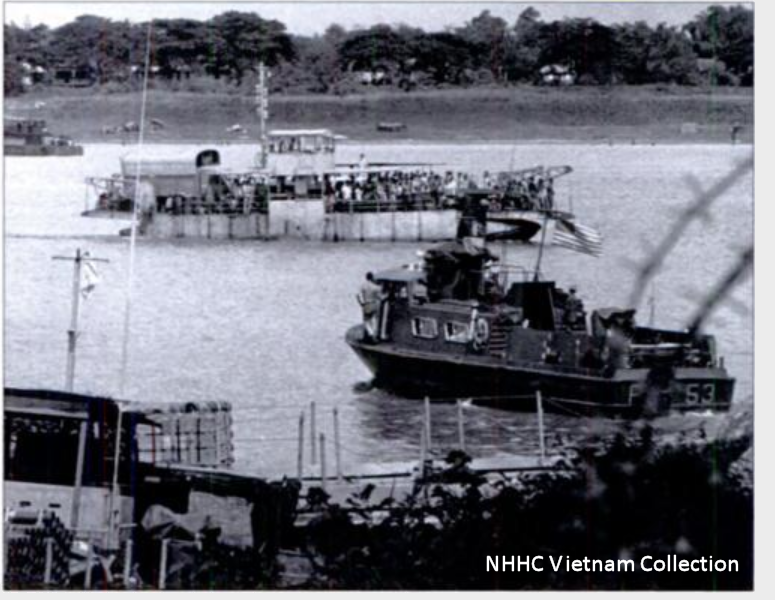
The Marine forces quickly established patrols to secure the surrounding area. Their force was augmented by an AirCav package, a dedicated air support unit comprised of: 4 UH-1 Huey "slick" helicopters, capable of carrying up to 13 troops each; 1 UH-1 Huey specially equipped for the Command and Control (C&C) mission; 2 OH-6 Cayuse Light Observation Helicopters (LOH); and 2 AH-1 Cobra gunships.
On the morning of May 14, the Vietnamese battalion commander and his U.S. Marine advisor, Captain Tom Draude, were in the C&C Huey canvasing an area near the hamlet of Chheu Kachat when they sighted a battalion-sized force of North Vietnamese Army regulars in what appeared to be a well-appointed R&R area. The rules of engagement prevented the allied troops from firing until they had been fired upon, so for what seemed an eternity the two forces watched each other without reacting. However, one of the LOH scout helicopters kept probing, making increasingly closer approaches until someone on the ground was goaded into taking the first shot. In the words of Draude, "the game was on."
The South Vietnamese battalion Executive Officer (Captain Nguyen Phan) and his advisor (Captain Ben Bender) were already patrolling near the area with a company of infantry and at around 1030 they made contact near Hill 147 (WT 426 435). They encountered heavy automatic weapons, machine gun, and recoilless weapon fire, so an additional infantry company was quickly inserted by helicopters. However, the ground fire soon became so intense that further reinforcement, resupply or evacuation were deemed impossible. Some 200 Vietnamese Marines and their American advisor were trapped.
The communists quickly initiated an intense, coordinated attack. The Marines held their ground and then made three unsuccessful counter assaults. Although wounded, Bender moved to a more exposed position where he could observe the NVA. He directed air strikes by the helicopter gunships and others throughout the rest of the afternoon.
When the ground forces made the initial contact, Captain Draude immediately called for additional air support, even broadcasting in the blind for any aircraft in the area to join the fight. It was during this period that a most bizarre incident occurred. After the incursion into Cambodia began, the anti-war protests in the U.S. had increased dramatically and public opposition to what was perceived as a broadening of the war grew rapidly. American presence initially had been limited to some 30 miles from the border. That line had now been moved further back and all Americans, advisors included, were to immediately reposition themselves short of the new line.
When he received his orders, Draude restated the gravity of his situation to his headquarters, that there was an American advisor on the ground trapped in a fierce firefight. The order from HQ was repeated, unchanged. Bender would somehow have to be pulled out of the action, their Vietnamese counterparts abandoned.
Draude's response was swift and to the point. Extracting Bender from the fight would be nigh on impossible under current conditions, but if they could get him out Draude would take his place to ensure U.S. air support would continue. He could not live with himself if he abandoned his Vietnamese allies. His only request was that his name be spelled correctly on his court martial documents. After some delay, a modification to his orders authorized him and Bender to stay and finish the fight.
After the failed counter assaults, the Marines were pinned down in rice paddies between the village and a nearby reservoir, with the only cover being behind 12-inch high dikes. Realizing his men were in an untenable situation, Captain Phan jumped up, brandishing an M-60 machine gun and led an escape to the reservoir where they established a defensive position behind the steeper banks.
As darkness fell the Marines were running low on ammunition and medical supplies and an emergency resupply by air was attempted. The intensity of automatic weapons fire prohibited the landing of helicopters, so Bender marked the location using a strobe light and ammo boxes and other supplies were kicked out of the helo doors into the dark below. He later said the heavy metal boxes falling all around in the dark was in many ways more frightening than the enemy threat.
CAPT Bender once more relocated himself to a more exposed position in order to better observe enemy movements but there was no more air support to direct. At one point it seemed hopeless. Captain Phan reached out his hand to his advisor and friend and said "Ong Ben, I think we'll not see the sun again, but we will take many of these bastards with us." From 1930 that night until 0600 the following morning, the Marines were under constant enemy fire and they repulsed four more massive attacks.
Back aboard USS BENEWAH, Rear Admiral Matthews recognized the deteriorating situation and was scouring the area for any available air support he could find, but everything had been committed to support other missions. He directed VAL-4's ready alert fire team of two OV-10 Broncos to be scrambled from the VNAF airfield at Binh Thuy.
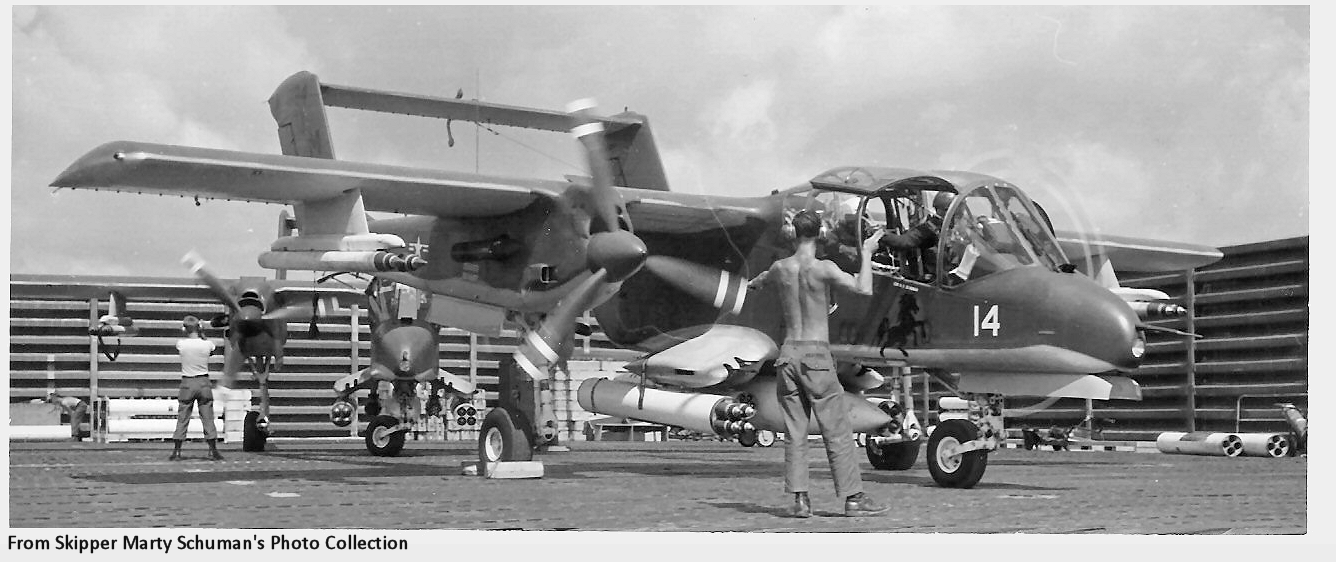
Ben Bender insists he had never heard of the Black Ponies before that night, but he was glad for any help he could get, whoever they were. And whatever they were, he would soon find that they were not helicopters nor were they lightly armed. The OV-10 Bronco had the speed to get there in short order, the fuel to loiter and make multiple attack runs, and the weapons needed to do major damage.
Today we are used to watching high tech weapon systems put round after round of "smart weapons" through a window, or onto the roof of a designated building in the middle of urban congestion. By today's standards, the Broncos in 1970 were primitively outfitted. There were no useful navigation aids to speak of and certainly no night vision equipment. Those tools were just around the corner, but not there yet. In today's parlance, the weapons were "dumb", or at least no smarter than the pilot who was shooting them.
[Ironically, almost a year to the day later, from the end of May through the end of August 1971, two YOV-10D Night Observation Gunship (NOGS) prototypes conducted combat evaluations working with the Black Ponies from VNAF Binh Thuy. With their night-piercing Forward Looking Infrared (FLIR) detection system, their rapid-fire 20mm cannon, and the heavy firepower of the Black Ponies, one can only imagine how much shorter the Battle of Chheu Kachat might have been.] - Charlie Sapp
On the ground, the only equipment Bender had to control the battle was a radio, a strobe light, and a compass. He would observe enemy fire, mark his position with the strobe light, call out a bearing and estimated distance, and the OV-10s would make a gun run trying not to overfly the friendly positions. Based on the impact of the tracers, he would provide a correction and the aircraft would then fire their heavier rockets for effect. Bender said the Black Ponies rockets were often hitting as close as 30 yards from his position. He also expressed his love for those "beautiful 5-inch Zuni rockets".
The Marines remained under constant fire but other Black Ponies were able to join the fray and Bender was able to control 18 sorties to keep the communist forces at bay throughout the night. As dawn approached, the enemy withdrew from the area under cover of darkness. According to Draude, the Navy Broncos had been the only air support available during the long night. They were "the critical, most significant factor" in the survival of 200 Vietnamese Marines and their American advisor.
Bailey remembers that he and Barton were the first flight to arrive at the battle and they were the last flight at the end. They returned to Binh Thuy to refuel and rearm at least twice, flying three sorties in support of the battle at Chheu Kachat. He couldn't say enough for the magnificent "pit crew" that waited eagerly to prepare the aircraft for another flight ... refueling, rearming, working off any discrepancies so they would be good to go. It was a long, exhausting night.
On the last flight, Bailey remembers: "In the morning, after the fighting had stopped, we did a visual recon of the area at about 200 or 300 feet above the ground. Much of the village appeared destroyed. We were told that some NVA officials were holed up in what was left of a large complex. We were directed to put in a strike, which we did, putting one Zuni through the front door of the main building for good measure." The official COMNAVFORV after action summary noted 49 enemy casualties were found, with evidence that many more had been taken away when the main NVA force withdrew.
Bender said the Marines quickly scoured the area for stragglers. He and Captain Phan were resting in the main square of the village when some of the troops walked up, smiling. They handed him an unopened bottle of Johnny Walker that had belonged to a senior NVA official. Those Vietnamese Marines recognized that the advisors' presence had assured the arrival of the critical air support by the Navy's Black Ponies and that he had directed it in such a way that they lived to see another day.
So, that is what the Black Ponies did in the war and the satisfaction of saving 200 lives is why no self-respecting attack pilot would ever want to be a fighter pilot.
Resources:
- • Bailey, Tom various e-mails
- • Bender, Lawrence, Captain USMCR, Silver Star citation
- • Bender, Lawrence, MAJ USMC (Ret) telephonic interviews
- • COMNAVFORV Monthly Historical Summary for May 1970
- • Cutter, Thomas J., Brown Water, Black Berets, pp. 352-355
- • Draude, Thomas, BGEN USMC (Ret) telephonic interview 11-8-2018 / e-mails
- • Lavell, Kit (2000). Flying Black Ponies: The Navy's Close Air Support Squadron in Vietnam
- • Marolda, Edward J. and Dunnavent, R. Blake; (2015) Combat at Close Quarters: Warfare on the Rivers and Canals of Vietnam; Naval History and Heritage Command
- • OV-10 Bronco Association (2015). The OV-10 Bronco: Designed for Insurgency and the Vietnam War (2015)
Webkeeper's Note: At the VAL-4 'Black Pony' 50th Anniversary Reunion in Pensacola, Florida - April 4 thru 2, 2019 Lawrence Bender and Thomas Draude met Tom Bailey and the other Black Ponies in attendance.
Major Ben Bender (seated) and Brig. General Tom Draude (USMC Retired)
Lawrence Bender, Aged 82, of Bradenton, FL. died Mar 27, 2020; survivors include his daughter's Mary K. and Susan, son Michael, sister Mary Anne, brother's Pete and Richard and five grandchildren; a private Memorial will be held.
Fair Winds and Following Seas Major.
On August 6, 1973, during the Cambodian Civil War and Vietnam War, Neak Leung was propelled to the centre of international attention when an American B-52 Stratofortress mistakenly dropped its 20-ton load on the town centre. At least 137 Cambodians were killed and another 268 were wounded. More than 30 craters stretched for a mile down the main street and a third of the town was completely destroyed while another third was heavily damaged. Neak Leung market and a large army barracks in the town were also destroyed. This incident was depicted by director Roland Joffe in his 1984 film "The Killing Fields".
